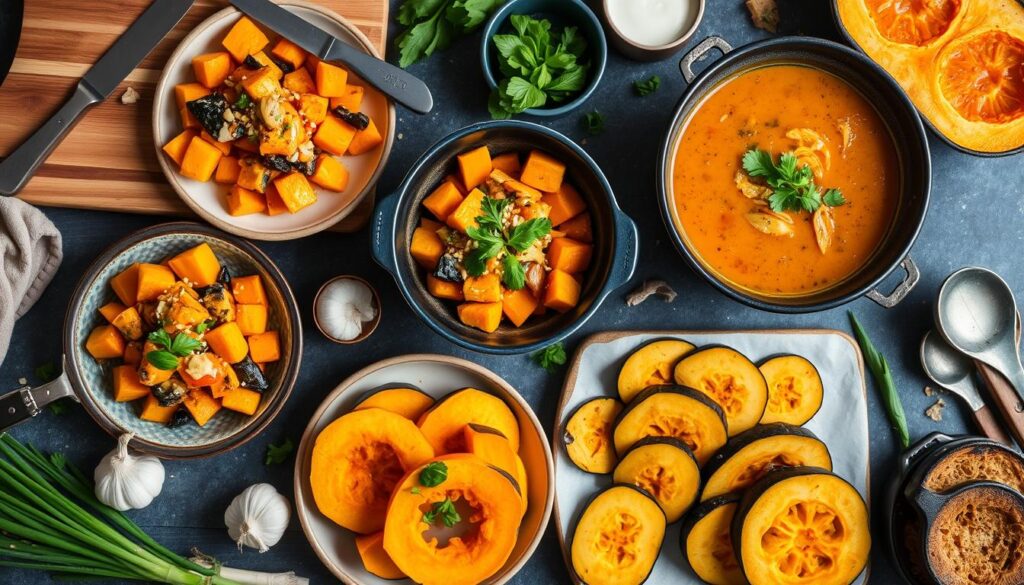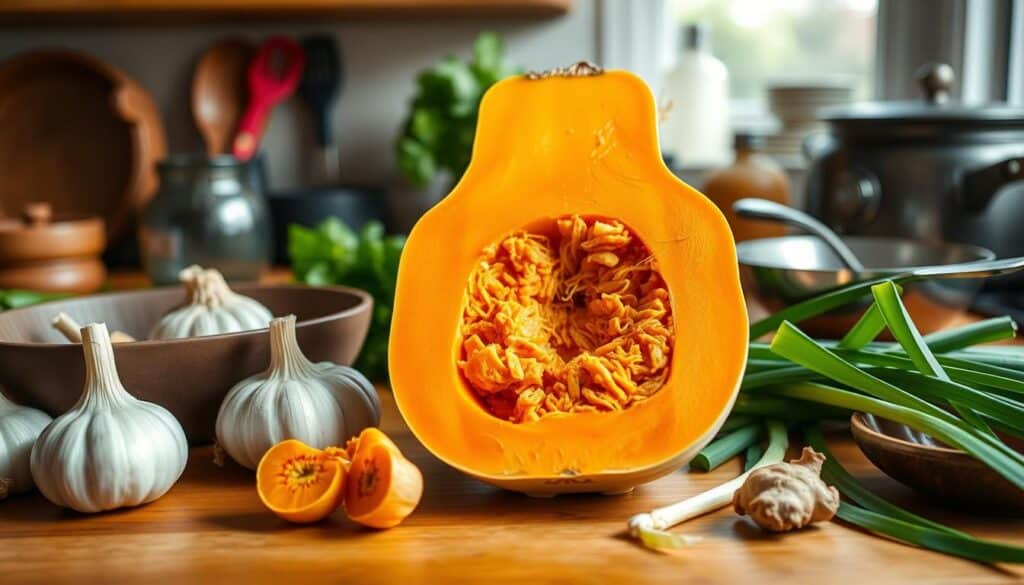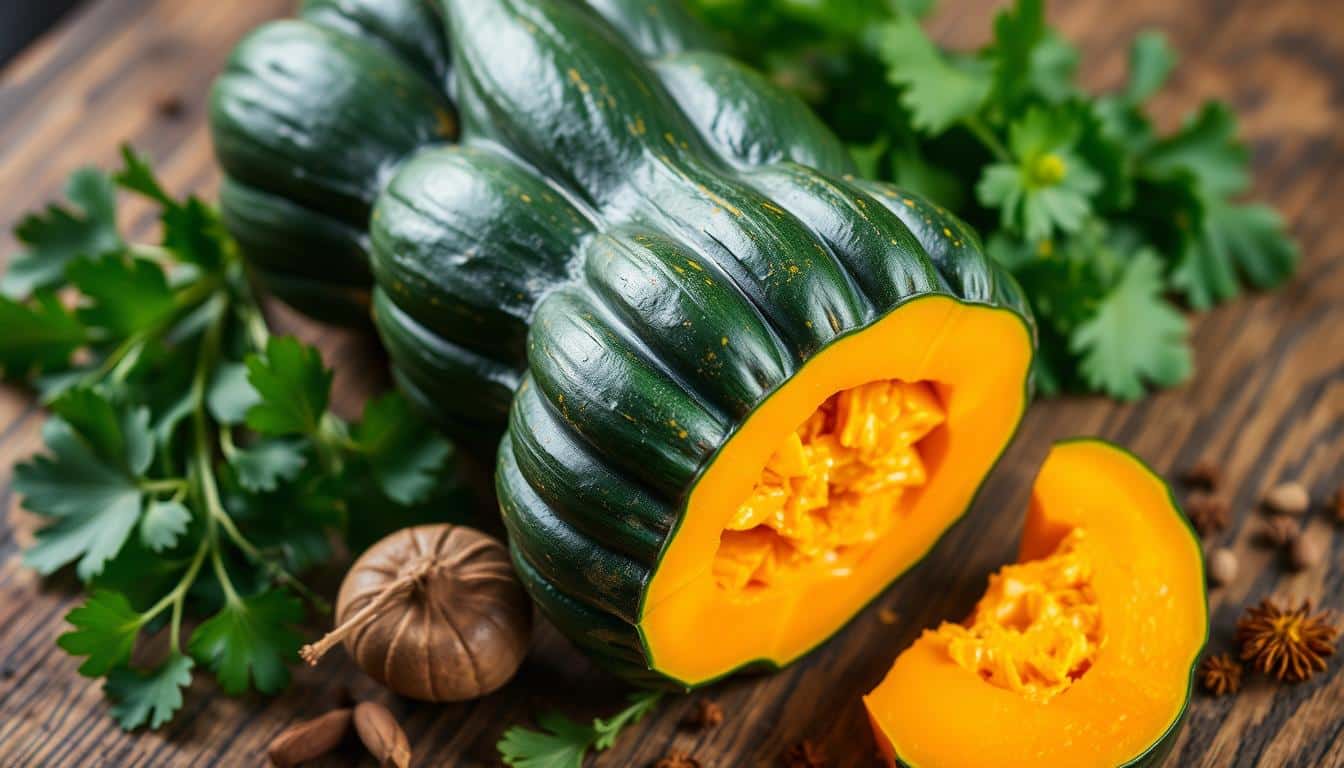As autumn arrives, I long for the warm tastes of my childhood. In my busy Chinese home, Kabocha squash and spices filled the air. Now, as a vegan, I love making tasty squash dishes that remind me of home.
Key Takeaways
- Discover the unique characteristics of kabocha squash, the Japanese pumpkin, and how it differs from other winter squash varieties.
- Learn essential techniques for selecting, preparing, and storing kabocha squash to ensure optimal flavor and texture in your recipes.
- Explore a variety of easy-to-follow vegan Chinese recipes that showcase the natural sweetness and nutty notes of kabocha squash.
- Understand the nutritional benefits of incorporating kabocha squash into your diet and how it can support your overall health and wellness.
- Embrace the seasonal availability of kabocha squash and incorporate it into your fall and winter cooking repertoire for a delicious taste of traditional Chinese flavors.
Understanding Kabocha Squash: The Japanese Pumpkin
Kabocha squash, also known as the Japanese pumpkin, is gaining popularity. It’s small to medium in size. Its dark green skin and vibrant orange flesh are eye-catching. The skin is thin and edible, becoming tender when cooked.
This squash is not just pretty. It’s also full of nutrients. It’s a great choice for healthy meals.
Identifying Quality Kabocha Squash
Choose kabocha squash that’s heavy for its size. It should have a dull, matte skin. Avoid any with blemishes or soft spots.
The stem should be intact. The shape should be rounded and symmetrical.
Nutritional Benefits and Health Value
Kabocha squash is full of vitamins, minerals, and fiber. It’s rich in beta-carotene, which turns into vitamin A. It also has vitamin C, potassium, and fiber.
These nutrients help with vision, immune function, and digestion. They offer many health benefits.
Seasonal Availability and Storage Tips
Kabocha squash is available from late summer to winter. Store it in a cool, dry place. This can be a pantry or cellar.
“Kabocha squash is a unique and nutritious vegetable that offers a wealth of culinary possibilities. Its versatility and health benefits make it a valuable addition to any kitchen.”
Essential Kitchen Tools and Ingredients for Chinese Kabocha Dishes
Preparing delicious Chinese dishes with kabocha squash needs the right tools and ingredients. Let’s explore what you need for these tasty vegan recipes.
A sharp, heavy-duty chef’s knife is essential for cutting through the tough kabocha squash. A sturdy spoon helps scoop out seeds and stringy flesh easily. For cooking, a large skillet or wok is perfect for stir-frying, sautéing, or roasting.
The key ingredients include soy sauce, brown sugar, fresh ginger, and Chinese five-spice powder. These flavors, sweet and savory, enhance the kabocha’s natural sweetness.
To add texture and nutty flavor, use toasted sesame seeds. For a spicy kick, try chili oil or fresh chilies in your recipe.
“Kabocha squash is a versatile ingredient that lends itself wonderfully to a variety of Asian-inspired dishes. With the right tools and ingredients, you can unlock a world of flavor in your asian kabocha squash recipes.”
With these essential items, you can make delicious vegan dishes with kabocha squash. It’s easy to bring out the squash’s creamy goodness in your kitchen.

Preparing Kabocha Squash: Essential Cutting and Cleaning Techniques
Kabocha squash, also known as the Japanese pumpkin, is great in kabocha curry recipes and chinese kabocha stew. But, its tough skin can be hard to cut. We’ll show you how to easily cut and clean this squash.
Safe Cutting Methods for Tough Squash
Kabocha squash is tough to cut. To make it softer, prick it with a fork and microwave for 2-4 minutes. This makes it easier to cut.
Use a sharp knife and a stable surface to cut safely.
Seed Removal and Preservation
Removing seeds from kabocha squash is easy. Just scoop them out with a spoon. You can roast the seeds for a tasty snack.
To Peel or Not to Peel
Kabocha squash skin is edible and gets soft when cooked. You can peel it for a smoother texture. Or, leave the skin on for extra nutrients and a nice look.
Learning these cutting and cleaning tips will help you make tasty kabocha curry recipes and chinese kabocha stew. You’ll enjoy the flavor and versatility of this Japanese pumpkin.
Easy Chinese Squash Recipes Kabocha Vegan: Step-by-Step Guide
Discover the flavors of vegan kabocha squash dishes with our guide. Kabocha squash, or Japanese pumpkin, is great for many easy Chinese squash recipes. These recipes are simple and fun, perfect for any cook.
One favorite recipe is simmering kabocha chunks in a mix of water, soy sauce, sugar, ginger, and five-spice powder. As it cooks, a tasty glaze forms, making the squash sweet and savory.
- Begin by cutting the kabocha squash into 1-inch cubes, keeping the skin on for extra texture and nutrition.
- In a skillet, mix the squash cubes, water, soy sauce, sugar, ginger, and five-spice powder.
- Let it boil, then lower the heat and simmer for 15-20 minutes. The squash should be tender and the liquid a sticky glaze.
- To add crunch, roast the vegan kabocha squash chunks in the oven at 400°F for 25-30 minutes, flipping them halfway.
| Ingredient | Quantity |
|---|---|
| Kabocha squash | 2.7 lbs, deseeded |
| Water | 1 cup |
| Soy sauce | 2 tablespoons |
| Sugar | 1 tablespoon |
| Ginger, minced | 1 tablespoon |
| Five-spice powder | 1 teaspoon |
Check out vegan Chinese squash dishes and find out about kabocha squash‘s flavors and health benefits. These easy Chinese squash recipes kabocha vegan will please your taste buds and nourish your body.

“Kabocha squash is the star of these easy Chinese squash recipes kabocha vegan. The mix of sweet, savory, and spice makes a delicious and healthy dish that’s sure to be a favorite.”
Five-Spice Glazed Kabocha: A Classic Chinese Method
The five-spice powder is key to this chinese kabocha recipes. It’s a mix of cinnamon, cloves, fennel, star anise, and Szechuan peppercorns. We simmer the kabocha pumpkin chinese cuisine in a mix of water, soy sauce, sugar, and five-spice powder. This makes a glossy, syrupy glaze that coats the squash perfectly.
Mastering the Five-Spice Blend
Getting the five spices right is important. You can use pre-made five-spice powder or make your own. To make your own, mix:
- 1 teaspoon ground cinnamon
- 1/2 teaspoon ground cloves
- 1/2 teaspoon ground fennel seeds
- 1/2 teaspoon ground star anise
- 1/4 teaspoon Szechuan peppercorns
Perfecting the Glaze Consistency
The perfect glaze comes from cooking time. We simmer the kabocha squash in the soy sauce, sugar, and five-spice mix for 20 minutes. This reduces the liquid into a glossy, syrupy coating. It takes patience, but the result is tender, flavorful kabocha with a beautiful sheen.
“The five-spice glaze really elevates the natural sweetness of the kabocha squash, creating a wonderfully balanced and addictive dish.”
Creative Asian Seasoning Combinations and Variations
Kabocha squash is great for trying new Asian-inspired flavors. Its sweet and nutty taste goes well with many spices and herbs. This lets us create many tasty dishes with it.
For a cozy fall dish, roast kabocha with cinnamon, nutmeg, and allspice. These warm spices make the squash taste even sweeter. It’s a dish that feels like home.
Want something fancy? Try a Parmesan and herb mix on roasted kabocha. The nutty cheese and fresh herbs balance its sweetness. Or, a maple and pecan glaze adds a sweet caramel taste.
For a tangy twist, top kabocha with pomegranate and goat cheese. The sweet and tangy mix is great with the squash. Add toasted pecans for crunch.
For an Asian flavor, use ginger-sesame dressing on kabocha. The ginger and sesame oil are perfect with the squash. A bit of soy sauce adds more flavor.
These ideas are just the start for asian kabocha squash recipes and kabocha curry recipes. Try different spices, sauces, and toppings. Find the mix that you love the most.
Conclusion
Kabocha squash is great for making easy Chinese squash recipes kabocha vegan. It’s full of nutrients and can be used in many ways. Home cooks can make tasty and healthy dishes with it.
Try making a five-spice glazed kabocha, a hearty squash soup, or a colorful stir-fry. There are so many ways to enjoy kabocha squash.
By using kabocha squash, we can make vegan meals that are both tasty and healthy. We can use fresh ingredients and bold flavors to make it stand out. Exploring kabocha squash lets us make more delicious and healthy plant-based dishes.
Let’s start a journey through easy Chinese squash recipes kabocha vegan. We’ll enjoy the vibrant flavors and health benefits of this amazing Japanese pumpkin. With creativity and a love for healthy cooking, we can make kabocha squash a culinary star.

